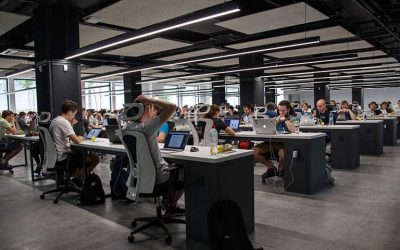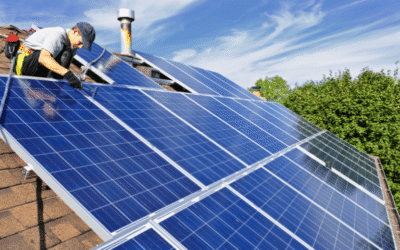Combining IoT and Smart Lighting: Optimizing Light for Efficiency
IoT and smart lighting make a powerful combination by connecting lights to a network that enables automated, adaptable lighting strategies. Common strategies include:
- Scheduled Timers: Scheduled timers optimize building lighting by setting specific times for lights to turn on and off automatically. This approach is especially useful for areas with predictable occupancy patterns, such as offices or parking garages, reducing unnecessary energy use when spaces are empty.
- Occupancy Sensors: Using IoT occupancy sensors, lights are activated only when someone enters a space. This automation prevents lights from staying on in unoccupied areas, which can be particularly beneficial in large spaces with low but occasional use, like storage rooms or stairwells.
- Daylighting: Daylight harvesting combines natural sunlight with artificial lighting. Incorporating natural lighting into a workplace reduces the need for indoor lighting and improves the ambiance of the space. IoT technology uses data to predict and adjust the indoor lighting throughout the day, minimizing the amount of electricity being used during the day.
These IoT lighting strategies collectively provide facility managers with adaptable, intelligent lighting solutions that reduce energy consumption while maintaining an optimal lighting environment for building occupants.
How Smart Lighting Contributes to Sustainability
Smart lighting technology integrated with IoT can significantly reduce electricity usage and pave the way for buildings to become more sustainable. In commercial buildings, lighting makes up 10% of fuel consumption throughout the United States. By connecting smart lighting systems with IoT, commercial buildings can predict when lighting is needed the most throughout the day and where. This cuts down unwanted electricity usage and lowers a business’s carbon footprint.
IoT generates data on the building’s usage, where it’s its most occupied and when. This helps property managers enable smart lighting settings throughout the building to reduce electricity usage. These settings can be adjusted by room, floor or zones of the building. This data-driven approach helps managers fine-tune their building to achieve their sustainability goals.
Other Benefits of Smart IoT Lighting
Beyond sustainability, IoT smart lighting offers facility managers a range of operational benefits, including:
- Improved Maintenance Alerts: IoT-enabled lighting systems have a proactive monitoring system to detect malfunctions or when lights reach the end of their lifespan. This helps reduce outages and increase the lifespan of lighting systems. With this technology, maintenance teams are able to act proactively without disruption to their business.
- Enhanced Comfort for Occupants: Another added benefit is advanced lighting controls can create a better environment for customers and employees. LED lighting and advanced lighting controls make the color and brightness adjustable. This can improve the health and well-being of tenants to create a more comfortable environment.
- Lower Utility Costs: By simply turning off lights in unoccupied rooms, buildings can see significant results in their utility bills. This is especially true in large-scale commercial buildings. This can even contribute to an increased ROI from the investment in IoT lighting technology.
Together, these benefits make IoT smart lighting a valuable investment for any facility manager looking to enhance building efficiency while creating a welcoming, sustainable environment.
Other Ways to Use Smart Technology in Building Management
While smart lighting is a powerful IoT application, other smart technologies are transforming building management. For instance:
- Smart HVAC Systems: IoT-based HVAC systems adjust heating and cooling based on occupancy and outdoor temperatures, ensuring efficient climate control and reducing energy usage.
- Air Quality Monitoring: IoT air quality sensors detect levels of CO₂, VOCs, and humidity, helping facility managers maintain a healthy indoor environment. These sensors can be linked with ventilation systems to adjust airflow in real-time, enhancing occupant comfort. This can be especially helpful in greenhouses and retailers that sell plants.
- Water Management: Smart IoT water management systems track water usage, detect leaks, and monitor temperature and pressure. This data allows for proactive water conservation and efficient maintenance of plumbing systems.
- Security Systems: IoT-enabled security cameras and motion detectors enhance building safety, with real-time monitoring and remote access capabilities for facility managers.
By integrating IoT across these systems, facility managers can create a cohesive, data-driven management strategy that not only enhances efficiency but also improves the overall experience for occupants.
Smart Lighting with Action Services Group
Businesses are looking for new, innovative ways to improve sustainability so they can brand themselves as environmentally conscious, lower carbon footprint and cut costs. Using IoT technology, smart lighting and advanced lighting controls may have a high upfront cost but leads to a long-term return on investment for the company. Combining IoT and smart controls has numerous benefits including creating a healthier, more comfortable environment for clients and employees. Property managers can leverage the latest technologies to improve the operations and efficiency of their facility.
Action Services Group provides expert advice on intelligent building controls, Internet of Things technology and a national provider and installer of advanced lighting controls. We can provide solutions to advance your facility into the future with the latest building management technology. To speak with one of our specialists, call 610-558-9773, email [email protected], or schedule a call that fits your needs by clicking the button below.










































0 Comments